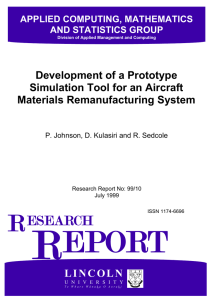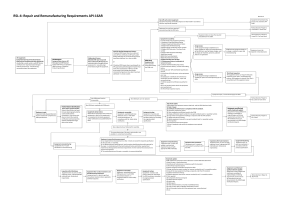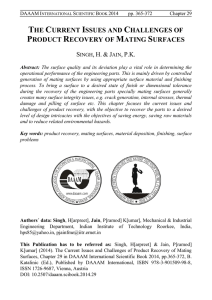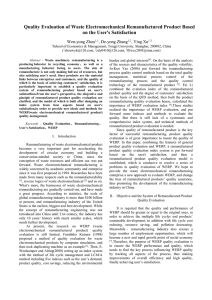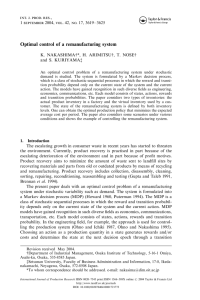MIT SCALE RESEARCH REPORT
advertisement
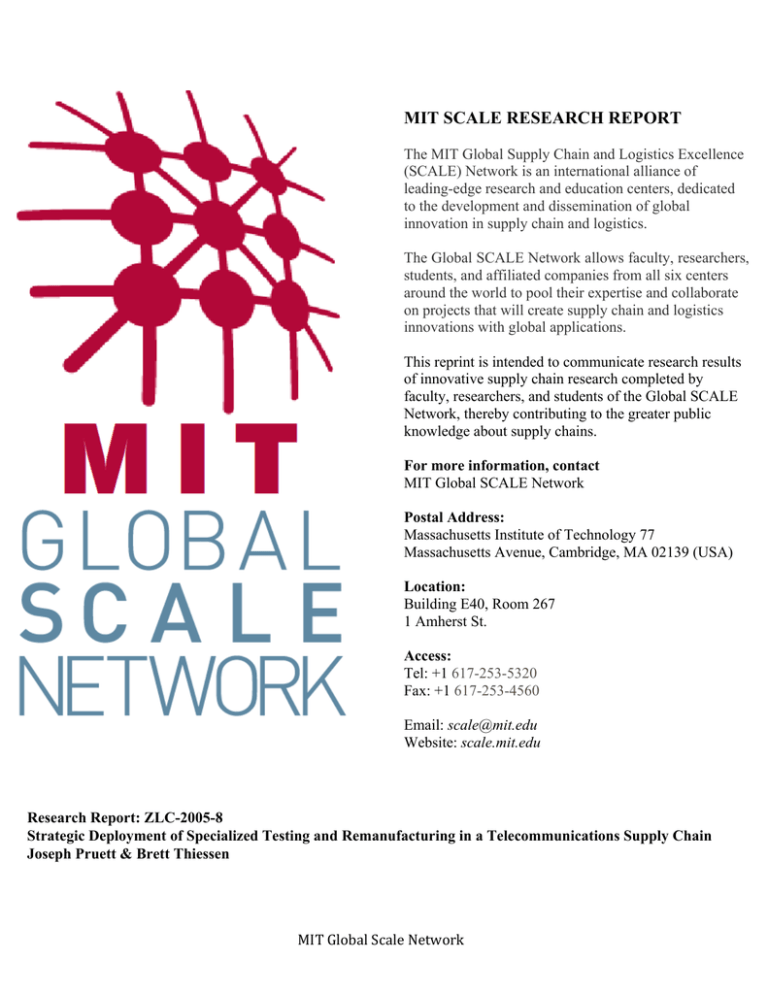
MIT SCALE RESEARCH REPORT The MIT Global Supply Chain and Logistics Excellence (SCALE) Network is an international alliance of leading-edge research and education centers, dedicated to the development and dissemination of global innovation in supply chain and logistics. The Global SCALE Network allows faculty, researchers, students, and affiliated companies from all six centers around the world to pool their expertise and collaborate on projects that will create supply chain and logistics innovations with global applications. This reprint is intended to communicate research results of innovative supply chain research completed by faculty, researchers, and students of the Global SCALE Network, thereby contributing to the greater public knowledge about supply chains. For more information, contact MIT Global SCALE Network Postal Address: Massachusetts Institute of Technology 77 Massachusetts Avenue, Cambridge, MA 02139 (USA) Location: Building E40, Room 267 1 Amherst St. Access: Tel: +1 617-253-5320 Fax: +1 617-253-4560 Email: scale@mit.edu Website: scale.mit.edu Research Report: ZLC-2005-8 Strategic Deployment of Specialized Testing and Remanufacturing in a Telecommunications Supply Chain Joseph Pruett & Brett Thiessen MITGlobalScaleNetwork For Full Thesis Version Please Contact: Marta Romero ZLOG Director Zaragoza Logistics Center (ZLC) Edificio Náyade 5, C/Bari 55 – PLAZA 50197 Zaragoza, SPAIN Email: mromero@zlc.edu.es Telephone: +34 976 077 605 MITGlobalScaleNetwork Strategic Deployment of Specialized Testing and Remanufacturing in a Telecommunications Supply Chain by Joseph Pruett & Brett Thiessen EXECUTIVE SUMMARY Supply chains are usually viewed as networks of different geographically dispersed facilities and the transportation links that connect the facilities. The major task of strategic supply chain design is implementing a network that maximizes economic performance on a long-term basis. This task has become more complex as corporate strategy increasingly spans international networks of owned and outsourced facilities. High tech and telecommunications industries are especially challenged given the highly dynamic supply and demand markets. New product introduction often involves high capital investment by Original Equipment Manufacturers (OEMs) in resources specific to their products – such as manufacturing and testing technologies. The OEMs must strategically deploy these specific resources across partners and locations, considering international regulations, financial concerns, and currency markets. These characteristics of outsourced supply chains, particularly in the high-tech electronics industry, offer unique opportunities for research in strategic network design. This thesis examines a circuit pack supply chain for an OEM that utilizes Electronics Manufacturing Services (EMS) providers with specialized resources for assembly, testing and remanufacturing. Although there are four main stages of the supply chain that we analyze – component suppliers, assemblers, warehouses, and customer regions – our emphasis in analysis lies in the complex interactions at the assembler portion of the chain. The OEM has selected a set of EMS providers to perform assembly, testing, and remanufacturing of these circuit packs. These EMS providers own all resources except for product specific testing equipment, which the OEM provides. EMS providers charge a per unit price for assembly, testing, and remanufacturing. EMS selection decisions are binding for three years and contracted allocation quantities are renegotiated on a yearly basis. Each assembler has maximums on both monthly and annual overages allowed as well as an annual minimum amount that the OEM must allocate. 1 Each individual circuit pack must be fully tested using test sets that are purchased by the OEM. A single test set may cost $1,000,000 and anywhere from 15-25 sets are required to cover the global supply chain. Furthermore, highly qualified, specially trained personnel are employed by the EMS provider to conduct the testing and testing capacity is not required at each EMS assembly site. Thus, assembled circuit packs may be shipped wherever testing is available. When a circuit pack is found to be defective, it must be remanufactured by skilled technicians either at the same location or another site. After remanufacturing, the pack must be tested again and sent back to remanufacturing if further defects are found. After a circuit pack has successfully passed testing, it is then sent to a regional warehouse to await staging for final customer delivery. The impact of testing and remanufacturing capacity decisions are further amplified by variable yield rates across assembly locations. Approximately two or three times per year, the OEM introduces product redesigns that go into effect at specific EMS locations. When a new product or major design change is introduced, the percentage of positive tests after initial assembly could drop from 95% to as little as 25% for short periods, though smaller drops in yields are experienced in many cases. It can take over a year to return to maximum yield. The product redesign introductions are staggered so that reductions in yield do not occur at all locations simultaneously. In our analysis, we found that the levels of aggregation for assembly, testing and remanufacturing resulted in a pyramid style build up. As a precondition, assembly was distributed among six international sites. We then set up an optimization model to determine how much would be manufactured when and where under the pre-existing contract parameters, where that product would be tested, where it would be remanufactured when necessary and finally which warehouses it would be shipped to in order to service end customer demand. The optimal results showed that the six levels of assembly were reduced to four locations for testing and two locations for remanufacturing. All the results were cross-checked for robustness against different demand and yield scenarios. The research was extended by examining the overall cost implications of reducing the testing locations to specific, predetermined locations. The result was an overall increase in cost of 8-20%. It proved to be more practical to buy additional test sets in low cost countries and not use pre-purchased sets in high cost countries to save on labor costs. Under no situations was it ever practical to maintain testing at all locations. In fact, across all scenarios, a minimum of 70% of testing took place at the two lowest cost countries no matter what the demand or yield scenarios dictated. 2 A final option for adding flexibility to a dynamic telecommunications supply chain is the option to make the circuit packs self-testable. By doing so, the need to make large capital investments in test sets is removed and the ability to cheaply test anywhere in the global supply chain, no matter labor costs, becomes a reality. The analysis found that at a cost of implementation below 1.5% of the total cost of goods sold (COGS), self-testing should be fully implemented. However, if the cost to implement rises beyond 1.5% up to around 4-5%, then a partial implementation becomes advantageous. Within this variable range, the higher cost countries should implement the self-testable packs while the low-cost countries should continue to use the existing infrastructure. There are tremendous amounts of difficulties facing modern global countries in their supply chains. The ability to deal with outsourced portions has become a critical competency for success. Our analysis has concluded that low cost labor has obvious benefits within the global supply chain, but that there are always trade-offs between the reduced labor and other issues such as shipping costs. One way to combat these higher costs is the elimination of intermediate stages, such as testing, which proved an effective solution in our study given the proper conditions. 3







